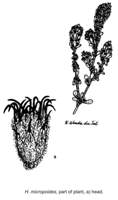Origin of name:
micro = small
Diagnostic characters:
Prostrate herb with bare older branchesYellow bractsVery small compact headsLeaves spathulate, small and woolly
Description:
Herb with a slender taproot, probably mostly annual, occasional specimens with woody taproot and base, branches few to many from the crown, prostrate or decumbent, mostly 20-150 mm long, very slender, simple or sparingly branched, loosely woolly, glabrescent, often reddish, distantly leafy except at the crown and under the heads. Radical leaves up to 15 x 6 mm, stem leaves sometimes smaller, upper leaves mostly 3-8 x 1.5-3 mm, obovate, spathulate or oblong-spathulate, apex obtuse, often folded lengthwise and strongly recurved, base narrowed, half-clasping, margins somewhat undulate, both surfaces glandular, loosely grey-woolly. Heads homogamous or heterogamous, narrowly campanulate, c. 3 x 2 mm, each opposite a leaf, solitary or few in small glomerules crowded towards the tips of the branchlets forming a leafy racemose compound inflorescence. Involucral bracts in 3-4 series, outermost short, webbed to surrounding leaves with wool, inner sub-equal, exceeding flowers, woolly on the backs, pellucid, sometimes red above the stereome, tips opaque, subacute to acuminate, mostly squarrose, straw-coloured to reddish. Receptacle nearly smooth. Flowers 8-23, 0-2 (-3) female, 8-22 homogamous, yellow, sometimes tipped red. Achenes 0.75 mm long, glabrous or with myxogenic duplex hairs. Pappus bristles many, equaling corolla, tips barbellate, bases scarcely cohering by patent cilia.
Flowers between July and November.
Distribution:
Grows in sand, sometimes forming a dense cover on sand dunes, or on hard-packed sand. Found in the southern part of Namibia and the arid parts of the Cape from L�deritz E. and SE. to the Kalahari Gemsbok National Park, Hay and De Aar, and S. through Namaqualand and the W. Karoo to Ceres.
Savanna, Succulent Karoo and Nama Karoo Biomes.
Notes:
H. micropoides is very variable in the degree to which the tips of the involucral bracts are produced; there is a tendency for plants in the E. half of the range to have bracts more markedly acuminate than in plants from the W. part, but there is neither discontinuity in bract length nor absolute geographical separation. Similarly, plants with homogamous heads are commoner in the W. than in the E.
The species can usually be recognized by the peculiar arrangement of the heads in racemose compound inflorescences, but this is not always clearly visible in young specimens. However, it is a character that serves to distinguish H. micropoides immediately from its close ally, H. leontonyx, which has heads crowded in terminal glomerules. Also, in H. leontonyx the heads are always heterogamous with generally more flowers and more female flowers than in H. micropoides.H. micropoides is also much confused with H. tinctum, which it resembles in the involucre. However, the pappus is clearly uniseriate, a character requiring careful observation; also, the heads are much smaller.
Taxonomy:
Literature:
Helichrysum micropoides DC., Prodr. 6: 170 (1838); Harv. in F.C. 3: 215 (1865); Merxm., F.S.W.A. 139: 96 (1967).
Type:
South Africa, Dr�ge 5811 (G-DC, holo.).
Synonym(s):
Gnaphalium micropoides (DC.) Sch. Bip. in Bot. Ztg 3: 169 (1845).
G. prostratum Thunb., Prodr. 150 (1800), Fl. Cap. 652,(1823); Less., Syn. Comp. 330 (1832); Harv. in F.C. 3: 262 (1865); non Helichrysum prostratum Hook. f. (1844). Type: Cape, Onder Bokkeveld, Thunberg (sheet 19234, UPS, holo.).
Helichrysum fllagineum DC., l.c.; Harv., l.c. Gnaphalium araneosum Sch. Bip. in Bot. Ztg 3: 169 (1845). Type: South Africa, Dr�ge 6339 (G-DC, holo.).
H. namaquense Schltr. & Moeser in Bot. Jb. 44: 295 (1910). Type: Namaqualand, Zabies, Schlechter 11224 (Z, holo.; BM; E; G; K; PRE; S; fragment NU, iso.).
Vouchers:
Acocks 15003 (PRE); Bolus 7441 (BOL; K); Compton 22008 (M; NBG); Merxm�ller & Giess 2993 (M; WIND); Wasserfall 1102 (K; M; NBG; PRE).


